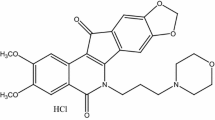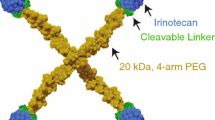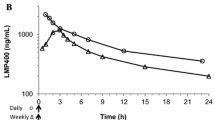Abstract
The topoisomerase I inhibtor topotecan is a potent water-soluble camptothecin derivative with activity in a wide variety of preclinical models. Topotecan exhibits schedule dependency in vivo, with the greatest activity being observed on repeated dose schedules. On the basis of the initial clinical studies that showed a short plasma halflife, we attempted to prolong drug exposure by giving topotecan as a 24-h infusion weekly. In a phase I trial, we treated 32 patients at doses ranging from 1.0 to 2.0 mg/m2. The patient population had not been heavily pretreated with chemotherapy and was of good performance status. The incidence of neutropenia, which was dose-limiting, increased sharply with relative small increments in dose. Doses greater than 1.5 mg/m2 were associated with nadirs that developed after one to three weekly treatments. A patient with metastatic colorectal cancer had a prolonged partial response. The plasma pharmacokinetics of topotecan (lactone and open forms) was characterized in 21 patients. Mean plasma steady-state drug levels were proportional to the dose and were within the range required to exert cytotoxicity in preclinical models. Plasma elimination curves were fit to a one-compartment model, in which the harmonic mean half-life of topotecan was 3.5 h. The ratio of the lactone to the total drug concentrations was constant throughout, which suggests that for this schedule the total drug concentration may be used as a measure of active lactone exposure. This conclusion is supported by the pharmacodynamic analysis, which revealed a positive correlation of both lactone and total drug steady-state concentrations with bone marrow toxicity. The further investigation of this and other infusional schedules in phase II trials will be conducted. The steady-state concentrations of total drug will be measured in several of these trials to establish its potential role in adaptive dosing using this schedule. Such a strategy is justified by the interpatient variability in toxicity and the steep dose-response curve observed in this study. Preliminary evidence of interpatient variability in the mRNA expression of topoisomerase I in the peripheral mononuclear cells and colon mucosa is presented. Trials are under way using biological endpoints for further selection of patients in whom the use of topoisomerase inhibitors may be therapeutically beneficial.
Similar content being viewed by others
References
D'Arpa P, Liu LF (1989) Topoisomerase-targeting antitumor drugs. Biochem Biophys Acta 989:163–177
Negoro S, Fukuoka M, Masuda N, et al (1991) Phase I study of weekly intravenous infusions of CPT-11, a new derivative of camptothecin, in the treatment of advanced non-small cell lung cancer. J Natl Cancer Inst 83:1164–1168
Kawato Y, Aonuma M, Hirota Y, et al (1991) Intracellular role of SN-38, a metabolite of the camptothecin derivative CPT-11 in the antitumor effect of CPT-11. Cancer Res 51:4187–4191
Shimada Y, Yoshino M, Wakui A, et al (1991) Phase II study of CPT-11, a new camptothecin derivative, in patients with metastatic colorectal cancer. Proc Am Soc Clin Oncol 10:135
Fukuoka M, Niitani H, Suzuki A, et al (1992) A phase II study of CPT-11, a new derivative of camptothecin, for previously untreated non-small-cell lung cancer. J Clin Oncol 10:16–20
Burris HA III, Hanauske A-R, Johnson RK, et al (1992) Activity of topotecan, a new topoisomerase I inhibitor, against human tumor colony-forming units in vitro. J Natl Cancer Inst 84: 1816–1820
Johnson RK, McCabe FL, Gallagher G, et al (1992) Comparative efficacy of topotecan, irinotecan, camptothecin and 9-amino-camptothecin in preclinical tumor models. Proceedings, 7th NCI-EORTC Symposium on New Drugs in Cancer Therapy, Amsterdam, March 17–20, 1992, p 85
Rowinsky EK, Grochow LB, Hendricks CB, Ettinger DS, Forastiere AA, Hurowitz LA, McGuire WP, Sartorius SE, Lubejko BG, Kaufmann SH, Donehower RC (1992) Phase I and pharmacologic study of topetecan: a novel topoisomerase I inhibitor. J Clin Oncol 10:647–656
Haas NB, LaCreta FP, Walczak J, Hudes GR, Brennan JM, Ozols RF, O'Dwyer PJ (1994) Phase I/pharmacokinetic study of topotecan by 24-hour continuous infusion weekly. Cancer Res 54:1220–1226
Beijnen JH, Smith BR, Keijer WJ, Van Gijn R, Bokkel Huinink WW ten, Vlasveld LT, Rodenhuis S, Underberg WJM (1990) High-performance liquid chromatographic analysis of the new antitumor drug SK&F 104864-A (NSC 606699) in plasma. J Pharmacol Biomed Anal 8:789–794
Statistical Consultants, Inc (1986) PCNONLIN and NONLIN84: software for the statistical analysis of nonlinear models. Am Stat 40:1
Gibaldi M, Perrier D (1982) Pharmacokinetics, 2nd edn. Marcel Dekker, New York
Horikoshi T, Danenberg KD, Stadlbauer THW, Volkenandt M, Shea LCC, Aigner K, Gustavsson B, Leichman L, Frosing R, Ray M, Gibson NW, Spears CP, Danenberg PV (1992) Quantitation of thymidylate synthase, dihydrofolate reductase, and DT-diaphorase gene expression in human tumors using the polymerase chain reaction. Cancer Res 52:108–116
Ng S-Y, Gunning P, Eddy R, Ponte P, Leavitt J, Shons T, Kedes L (1985) Evolution of the functional human β-actin gene and its multipseudogene family: conservation of non-coding regions and chromosomal dispersion of pseudogenes. Mol Cell Biol 5:2720–2732
D'Arpa P, Machlin PS, Ratrie H III, Rothfield NF, Cleveland DW, Earnshaw WC (1988) cDNA cloning of human DNA topoisomerase I: catalytic activity of a 67.7-kDa carboxyl-terminal fragment. Proc Natl Acad Sci USA 85:2543–2547
Kanzawa F, Sugimoto Y, Minato K, et al (1990) Establishment of a camptothecin analogue (CPT-11)-resistant cell line of human nonsmall cell lung cancer: characterization and mechanism of resistance. Cancer Res 50:5919–5924
Chang J-Y, Dethlefsen LA, Barley LR, et al (1992) Characterization of camptothecin-resistant Chinese hamster lung cells. Biochem Pharmacol 43:2443–2452
Sugimoto Y, Tsukahara S, Oh-Hara T, et al (1990) Decreased expression of DNA topoisomerase I in camptothecin-resistant tomor cell lines as determined by a monoclonal antibody. Cancer Res 50:6925–6930
van der Zee AGJ, de Jong S, Keith WN, Hollema H, Boonstra H, de Vries EGE (1994) Quantitative and qualitative aspects of topoisomerase I and IIα and β in untreated and platinum/cyclophosphamide treated malignant ovarian tumors. Cancer Res 54:149–155
Kudelka A, Edwards C, Freedman R et al. (1993) An open phase II study of evaluate the efficacy and toxicity of topotecan administered intravenously as five daily infusions every 21 days to women with advanced epithelial ovarian cancer. Proc Am Soc Clin Oncol 12:259
Schiller J, Kim K, Johnson D (1994) Phase II study of topotecan in extensive stage small cell lung cancer. Proc Am Soc Clin Oncol 13:330
Hochster H, Liebes L, Speyer J, Sorich J, Tanbes B, Oratz R, Wernz J, Chachoua A, Raphael B, Vinci RZ, Blum RH (1994) Phase I trial of low dose continuous topotecan infusion in patients with cancer: an active and well-tolerated regimen. J Clin Oncol 12:553–559
Husain I, Mohler JL, Seigler HF, Besterman JM (1994) Elevation of topoisomerase I messenger RNA, protein and catalytic activity in human tumors: demonstration of tumor-type specificity and implications for cancer chemotherapy. Cancer Res 54:539–546
Szarka CE, Pfeiffer GR, Frucht H, Goosenberg EB, Litwin S, Engstrom PF, Clapper ML (1994) Glutathione S-transferase activity of blood lymphocytes as a marker of human colon glutathione S-transferase activity. Proc Am Assoc Cancer Res 35:633
Yao K-S, Godwin AK, Ozols RF, Hamilton TC, O'Dwyer PJ (1993) Variable baseline γ-glutamylcysteine synthetase messenger RNA expression in peripheral mononuclear cells of cancer patients, and its induction by buthionine sulfoximine treatment. Cancer Res 53:3662–3666
Author information
Authors and Affiliations
Additional information
This work was supported in part by grant CA06792 from the National Cancer Institute (NCI, NIH, DHHS) and by an appropriation from the Commonwealth of Pennsylvania
Rights and permissions
About this article
Cite this article
O'Dwyer, P.J., LaCreta, F.P., Haas, N.B. et al. Clinical, pharmacokinetic and biological studies of topotecan. Cancer Chemother. Pharmacol. 34 (Suppl 1), S46–S52 (1994). https://doi.org/10.1007/BF00684863
Issue Date:
DOI: https://doi.org/10.1007/BF00684863




